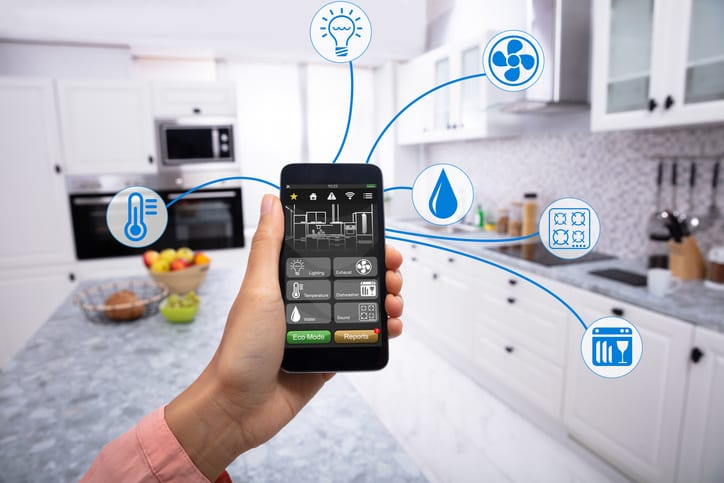
Smart Home Automation Guide
Smart home technology is becoming more commonplace in new home construction, as home automation features are proving attractive to millennials and older homeowners alike. The smart home market is expected to expand to an estimated 480 million homes throughout the world by 2025. Smart homes use Wi-Fi-connected Internet of Things (IoT) devices to improve your quality of life via remote control and automation. Many new homes feature built-in security systems and voice-command assistants in every room. Apps on your phone can control appliances remotely and alert you when something in your home needs attention.
Each home in Northlake’s Pecan Square by Hillwood community includes Canopy, Hillwood’s complete-coverage home technology bundle. Each house includes smart home basics like high-speed internet, full-house Wi-Fi coverage, a Ring Video Doorbell, and an Amazon Echo Show. If you are just getting started with home automation, it may seem a bit overwhelming. The following smart home guide can help you learn about home automation and the ways smart home technology can make life easier.
Your Home Automation Checklist
The items you include on your home automation checklist will be determined by the needs of your household. More than 46% of homeowners choose their home automation setup based on the convenience that a device adds to their daily lives. The second-most cited reason for home automation is the added sense of security such devices provide. Homeowners with limited mobility or a disability find that smart home devices can provide accessibility technologies that improve their quality of life.
Another important feature for beginner home automation users is saving on their energy bills by controlling their heating and cooling systems and appliances. The following tips can help you set up smart home features that add convenience, provide security, and offer energy savings.
Guide to Smart Home Enjoyment and Ease of Living
The most common reason homeowners purchase smart homes is the added convenience it brings to their daily lives. A smart home with complete Wi-Fi coverage allows you to remotely monitor and control appliances such as refrigerators, garage door openers, and laundry machines. Voice commands can streamline daily tasks, assisting with everything from turning off lights and locking doors to finding a recipe. Some of the more popular smart home devices for simplifying your daily routine include:
- Smart appliances with AI and internal cameras. These allow you to see inside the fridge or other appliances remotely, making it easier to tell if you need that one thing on your grocery list.
- Remote control features that lock the door, turn off the lights, or turn off the AC from your phone if you forgot when you left for work.
- Smart displays like Amazon’s Echo Show connect all of your IoT devices for easy central control. This means you can use voice commands to choose TV shows or movies, have a recipe read to you while you’re cooking, or turn on your favorite cooking playlist.
- Geofencing applications recognize when you’re close, and turn on the lights, open the garage, and unlock the door.
Smart House Guide for Safety and Security
Nearly 37% of homeowners look for home automation devices related to fire alarms and theft protection. These security systems use motion sensors and cameras linked to a private security company or the local police department. Some smart homes can be equipped with keycard or fingerprint identification systems to deter break-ins. Smart house security systems alert you if your windows are open and provide direct video surveillance of the perimeter of your home. Some smart home devices allow you to remotely detect power outages or smoke and carbon monoxide problems. You can also purchase sensors to detect water leaks around water heaters, washing machines, or dishwashers. When you are deciding how to set up a smart home that can enhance your safety and security, look for the following products:
- Smart doorbells such as Ring Video Doorbell that can visually monitor who is at your door.
- Smart displays such as the Amazon Echo Smart which will provide a central location for monitoring and controlling your home’s security system, lighting, and appliances.
- Indoor and outdoor cameras that can be controlled by remote apps.
- Smart lighting that uses light control modules in tandem with smart displays and security systems.
Ultimate Smart Home Guide for the Environment and the Outdoors
Smart homes can increase energy efficiency by shutting off lights when no one is in the room, closing the curtains remotely to keep the house cooler, and adjusting the temperature when no one is home or prior to your return. Certain devices can track your energy usage, saving you money and helping the environment.
Smart home devices can also use automation to help you with outdoor chores. Some popular smart devices that can help with yard work include:
- Robot lawn mowers that use Bluetooth and cellular radios to connect with your phone. A GPS system in the lawn mower tracks its progress throughout your property.
- Smart irrigation systems control sprinklers to water the yard based on weather conditions or a schedule you set up.
- Robotic pool cleaners with four-wheel-drive that you control from your phone.
Visit Pecan Square
At Pecan Square, our Canopy bundle is a standard feature in all our homes. Let us show you how smart home automation can make your life easier. Contact us for more information or take a virtual tour of our homes.